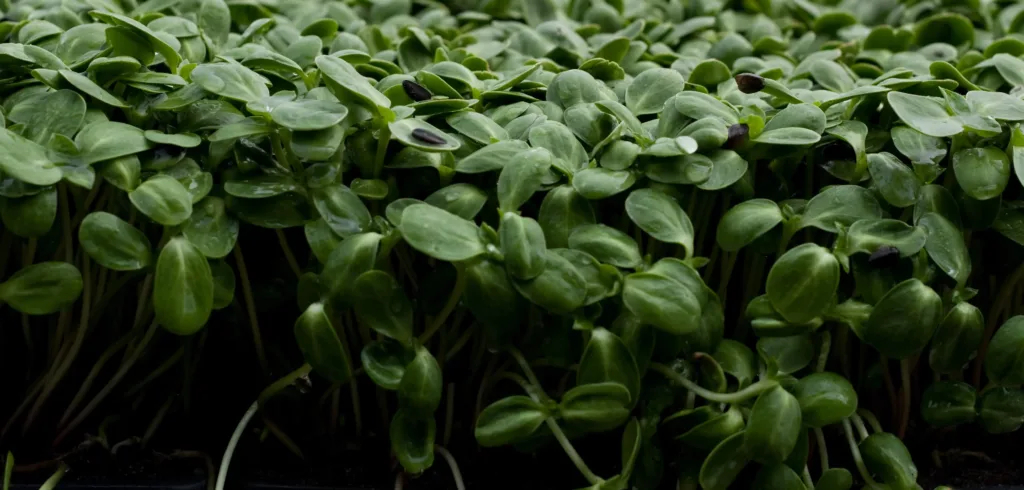When we talk about light quality we are talking about the spectra of the light – the specific wavelengths between 400 and 700 nm – that are emitted by a light source. Light quality is often displayed in a spectral chart (see example to the right) or detailed in accompanying spectrum test reports.

Understanding light quality is important for several reasons:
- Different light wavelengths induce different crop responses, usually focused on vegetative growth and flowering.
- Chlorophyll absorption peaks at around 450 nm (Blue) and 650 to 680 nm (Red)
- Relative proportions of different spectra affect crop growth
- DIfferent wavelengths are more or less efficient at supporting photosynthesis
Light quality plays an important role in crop growth, but unlike your PPFD and DLI – light quality cannot be easily changed without changing the whole fixture – so be sure to choose your fixtures well!
8.1. Light Spectral Ranges
The general spectral ranges of visible light are usually summarized as follows:
- Blue Light: 400 nm to 500 nm
- Green Light: 500 nm to 600 nm
- Red Light: 600 nm to 700 nm
Different combinations and proportions of these light wavelengths give the light emitted by fixtures different colors which typically range from white to yellow to purple to pink (and more!). Keep in mind, light colors don’t combine like crayon colors. Red and Blue and Green together in the right proportions, for example, make a white light.
Spectrum charts, like the one shown above, typically accompany lighting systems to give you the distribution of light they emit. Lighting color is also often given in Kelvin (K) as well. The lower K values are a more yellow light – High-pressure sodium (HPS) lights for example are at about 2200 to 2700 K. The higher the K value, the greater the amount of blue light.
We can break visible light into specific wavelengths, with each range having different impacts on crop growth:
- Violet Light: 380 nm to 450 nm
- Short wavelengths and high energy support vegetative growth
- Chlorophyll a and Carotenoids absorb light in this spectral range
- Blue Light: 450 nm to 485 nm
- Short wavelength and high energy
- Stimulates chlorophyll production, stem elongation, leaf growth, strong roots
- Stimulates auxin growth hormones and triggers stomatal opening
- Cyan Light: 485 nm to 500 nm
- Typically grouped with the blue range and has the same qualities
- Green Light: 500 nm to 565 nm
- Can promote shoot growth while inhibiting root growth
- Penetrates canopy to induce photosynthesis in lower leaves
- Supports plant survival when stressed
- Yellow Light: 565 nm to 590 nm
- Not effective for photosynthesis
- Combines with other colors to influence plant growth and may help plants deal with stress
- Can cause excessive stem elongation
- Orange Light: 590 nm to 625 nm
- May support seedling growth
- Combines with other colors to influence plant growth
- Red Light: 625 nm to 750 nm
- Major driver of photosynthesis
- Breaks seed dormancy
- Helps plants produce antioxidants and auxin
- Important for fruiting and flowering later in a plant’s life cycle
- Far-Red Light: 700 nm to 800 nm
- The red range from 700 nm to 800 nm but mostly from 700 nm to 750 nm
- The Red:Far-Red ratio affects stem elongation and branching
- More and more research is suggesting far-red light is more important to plant growth than previously thought
8.2. Microgreens Spectra Guidelines
Microgreens are basically a vegetative crop as we are not taking them to the flower or seed stage. So as a general rule, they do well with a balanced, full-spectrum light with good amounts of blue, red, and green light.
Our previous post shared what we have found, in our research, to be the best light balance so far:
- Red: 37.5%
- Green: 42.0%
- Blue: 20.5%
This “recipe” does not have to be exact, but rather can be used as a guideline when choosing lights for your system.
When it comes to choosing light by K value microgreens, a basic rule to follow is that they do well with a K value between 5500 and 6500, which promote vegetative growth over fruiting or flowering growth.
If you want to promote stem elongation in your crops (which most do not need), you can supplement your lighting with far-red light, either on the last day or two of the growth cycle, or at the end of each day of crop growth during the light stage.

Leave a Reply